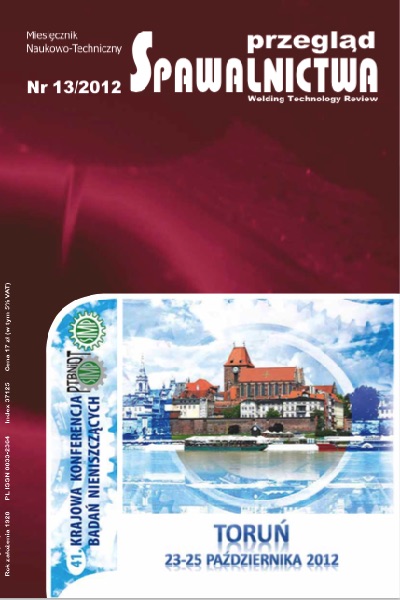Porównanie szumu Barkhausena i własnego magnetycznego pola rozproszenia w odkształconych plastycznie próbkach ze stali S235 i P265GH
Main Article Content
Abstract
Zmiany stanu wytężenia, struktury i temperatury tworzywa ferromagnetycznego wpływają na zmiany stanu równowagi energetycznej na poziomie atomowym, skutkując zmianami makroskopowych właściwości magnetycznych i elektrycznych. W artykule przedstawiono wyniki pomiarów szumu Barkhausena i własnego magnetycznego pola rozproszenia WMPR w próbkach odkształconych plastycznie. Porównano rozkłady wielkości ilościowo opisujących szum Barkhausena i WMPR. Stwierdzono, że zróżnicowanie stopnia deformacji plastycznej dobrze oddają energia szumu Barkhausena EBN, liczba zliczeń NBN oraz gradienty składowych WMPR. Czułość tych sygnałów diagnostycznych jest zbliżona. możliwe jest opracowanie ilościowych relacji diagnostycznych służących do oceny stopnia deformacji na podstawie ww. wielkości. Opracowanie rzetelnych relacji diagnostycznych wymaga rozwiązania szeregu problemów metrologicznych. Są one związane z wpływem kształtu i wielkości elementu, stanem warstwy wierzchniej, struktury oraz ogólnego stanu namagnesowania.
A comparison of barkhausen noise and the residual magnetic field in plastically deformed samples made of S235 and P265GH steel
Abstract
Changes in the stress state, structure and temperature of a ferromagnetic material result in changes in the balance of energy at the atomic level, causing variations in macroscopic magnetic and electrical properties. The paper presents the results of measurements of Barkhausen noise and of the residual magnetic field (RMF) in plastically deformed samples. A comparison is made of the distributions of values which describe Barkhausen noise and the RmF quantitatively. It is found that the differences in the degree of plastic deformation are well reflected by the energy of Barkhausen noise EBN, the number of counts nBn and the gradients of the RmF components. The sensitivity of these diagnostic signals is similar. It is possible to develop quantitative diagnostic relations that could be used to assess the degree of plastic deformation based on the values mentioned above. The development of reliable diagnostic relationships requires a solution to a series of metrological problems which are related to the impact of the shape and size of the component, to the state of the surface layer, the structure and to the overall state of magnetisation.
Downloads
Article Details
Creative Commons CC BY 4.0 https://creativecommons.org/licenses/by/4.0/
Welding Technology Review (WTR) articles are published open access under a CC BY licence (Creative Commons Attribution 4.0 International licence). The CC BY licence is the most open licence available and considered the industry 'gold standard' for open access; it is also preferred by many funders. This licence allows readers to copy and redistribute the material in any medium or format, and to alter, transform, or build upon the material, including for commercial use, providing the original author is credited.
References
Jiles D.C.: Theory of the magnetomechanical effect, J. Phys. D: Appl. Phys., 28 (1995) s. 1537-1546.
Deputat J.: Podstawy metody magnetycznej pamięci metalu. Dozór Techniczny 5/2002 s. 97-105.
Dubow A.A.: Principal features of metal magnetic memory method and inspection tools as compared to known magnetic nDT methods. WCnDT 2004, montreal Canada, http://www. ndt.net/article/wcndt2004/papers/359.ntm.
Roskosz M. Gawrilenko P.: Analysis of changes in residual magnetic field in loaded notched samples, nDT&E International 41 (2008) s. 570-576.
Roskosz M.: Wpływ naprężeń czynnych i resztkowych na własne pole magnetyczne ferromagnetyków, Przegląd Spawalnictwa 13/2011, s. 46-49.
Roskosz M., Bieniek m.: Evaluation of residual stress in ferromagnetic steels based on residual magnetic field measurements NDT&E International 45 (2012), s. 55-62.
Roskosz M.: Feasibility of Stress State Assessment on the Grounds of measurements of the Residual magnetic Field Strength of Ferromagnetics, Electromagnetic nondestructive Evaluation (XIV).
Chady T., Gratkowski S., Takagi T., Udpa S., (Eds Studies in Applied Electromagnetics and mechanics 35, IOS Press, 2011, s. 339-47.
Żurek Z.H.: magnetic contactless detection of stress distribution and assembly defects in constructional steel element, NDT&E International 38 (2005) s. 589-595.
Mierczak L.L., Jiles D.C., Fantoni G.: A new method for Evaluation of mechanical Stress Using the Reciprocal Amplitude of magnetic Barkhausen noise IEEE Transactions on magnetics, VOL. 47, no. 2, 2011, s. 459-65.
Piotrowski L., Augustyniak B., Chmielewski m, Tomáš I.: The influence of plastic deformation on the magnetoelastic properties of the CSn12021 grade steel, Journal of magnetism and magnetic materials 321 (2009) 2331-2335
Stupakov O., Takagi T., Uchimoto T.: Alternative magnetic parameters for characterization of plastic tension, NDT&E International 43 (2010), s. 671-676.
White S., Krause T., Clapham L.: Quantitative analysis of surface Barkhausen noise measurements, Review of Quantitative
nondestructive Evaluation. Vol. 27, ed. by D.O. Thompson and D. E. Chiment, 2008 American Institute of Physics.
Roskosz m., Fryczowski K.: możliwości wykorzystania zmian właściwości magnetycznych do oceny stanu wytężenia stali kotłowych na przykładzie stali P265GH, 4 Konferencja Naukowo-Techniczna Diagnostyka materiałów i Urządzeń Technicznych, Gdańsk 2012.
Roskosz m., Bieniek m.: Opracowanie i weryfikacja metody oceny naprężeń resztkowych i-rzędu dla próbek ze stali kotłowej 16mo3, 4 Konferencja naukowo-Techniczna Diagnostyka materiałów i Urządzeń Technicznych, Gdańsk 2012.
